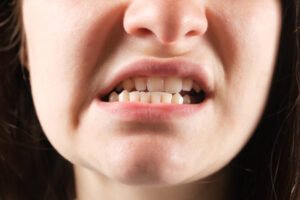
Jaw Pain Causes
Jaw pain and soreness can have a number of different causes, including a traumatic injury to the face. Trauma can result in a variety of dental problems including a complex condition called Temporomandibular Joint Disorder (TMD). Many types of blunt trauma can result in damage to the upper or lower jaw or the temporomandibular joint (TMJ)—which is actually a set of paired joints, one on each side of the face, situated just in front of the ear canals.
Blows to the face from sports accidents, motor vehicle collisions, and falls are just a few of the things that can cause jaw injury; the pain that results may range from mild to severe. A damaged jaw may be actually broken (fractured), or it may be dislocated, meaning that it has shifted out of its proper position. This type of injury may also involve loosened or displaced teeth, a broken condyle (the ball-like piece at the head of the TMJ), and/or lacerations (cuts) and swelling.
Regardless of what caused the injury, jaw pain is often accompanied by muscle spasm in one or more of the large muscles on either side of the jaw. Following stress or injury, these muscles may lock up, essentially “freezing” the jaw in position in the body’s attempt to prevent further damage.
Broken Jaw
After a serious facial injury, medical professionals often suspect a jaw fracture. Symptoms of a broken jaw may include: facial bruising, swelling, or bleeding; stiffness of the jaw or difficulty opening or closing the mouth properly; pain or tenderness that gets worse when chewing; loosened teeth; and numbness of the face or lips. However, the only way to tell for sure if the jaw is broken is to have a thorough physical examination with diagnostic imaging (such as x-rays).
If you have a broken jaw you should seek prompt medical evaluation and treatment. While on the way to the emergency room or medical care provider, you can hold the jaw in place with your hands to help reduce pain caused by movement. Alternatively, you can bandage it with a cloth that wraps under the jaw and over the head. However, the bandage must allow you to breathe freely and should be easily removable in case it is necessary to vomit. Apply ice or a cold pack to the outside of the injured area to help ease the pain. However, the bandage must allow the patient to breathe freely, and should be easily removable in case it is necessary to vomit. You should apply ice or a cold pack to the outside of the injured area to help ease the pain and swelling.
The dentist will determine whether to wire the broken jaw shut for a few weeks or allow it to heal on its own, based on the severity of the fracture. Repairing moderate or severe fractures may require surgery and dental work. During the healing period, the dentist will likely recommend a diet of liquids (and possibly soft foods). also may prescribe pain medication and antibiotics, especially if a tooth socket is fractured.
Dislocated Jaw

The symptoms of a dislocated jaw are similar to those of a broken jaw, but are sometimes less severe. They include: difficulty speaking and/or eating; inability to close the mouth properly; a bite that feels “crooked”, or teeth that don’t align properly; drooling or protrusion of the jaw; and pain in the affected area, which often gets worse when the jaw moves. However, as with a broken jaw, a prompt medical evaluation with x-rays is necessary to confirm the diagnosis.
For a dislocated jaw, administer the same first aid as for a fractured jaw. However, treatment may differ, as a medical professional can sometimes manually re-position the jaw with the aid of anesthetic and muscle-relaxing medications. When the medical professional puts the jaw back in position, they may stabilize it with bandages or other methods. Afterward, the patient may need to avoid eating hard foods or opening the mouth wide for a period of several weeks.














Leave a Reply